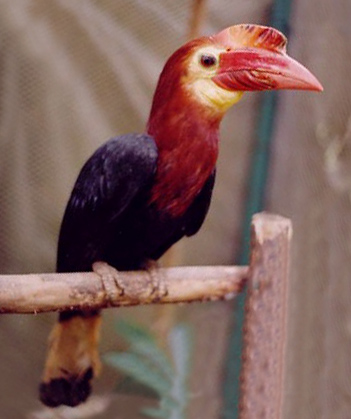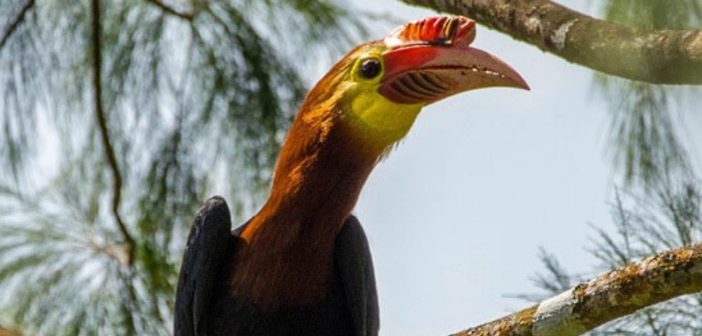Written by David Quimpo, Haribon Foundation
After two days of trekking through the mountains – across rivers, steep cliffs, and towering ridges – we reach the site, 741 meters above sea level. We are in the northern part of the Central Panay Mountains Key Biodiversity Area in Antique, Philippines. The trees of the montane forest grow densely around us, mostly undamaged by human activity.
Carefully, we began searching the trees around us for holes. If we are lucky, we might find a nest hole for one of the most elusive birds in the Philippines – the rufous-headed hornbill (Rhabdotorrhinus waldeni). Known locally as dulungan, they are endemic to the Panay and Negros Islands in Central Philippines, and critically endangered.

A dulungan on a perch. Image credit Callan Bentley, CC BY-SA 3.0.
The dulungan is a victim of forest destruction and hunting. Their habitat has been severely deforested, as only 23% of the Philippines’ original forests remain. With less forest to hide in, the dulungan is more susceptible to hunters. The Haribon Foundation (BirdLife’s Partner in the Philippines) has been working hard to educate local communities close to the Central Panay Mountains about forest and wildlife protection. In 2017, the National Grid Corporation of the Philippines formed a partnership with the Haribon Foundation to support dulungan conservation.
Through this partnership we were able to train and deputize 22 forest guards to watch over the dulungan and the biodiversity of the Central Panay Mountains. Local schools are now supporting the conservation of the species and students are implementing projects to reduce waste and develop tree nurseries to help restore the habitat of the dulungan. As the flagship species of the provincial government of Antique, a local fete, the Madja-as Festival, celebrates the species. A locally managed protected area has been established by the local governments of Culasi and Sebaste with support from the Department of Environment and Natural Resources.
As we trek through the wilderness, badgered by mosquitoes and leeches, we are finally rewarded by seeing the fruit of these projects – a hole in a Tanguile tree. This isn’t just any hole though, it is the nest of a dulungan. Blending in with our surroundings as best we can, we are excited to hear his goat-like call ringing throughout the forest. I ready my camera as the dulungan flies into the open, nearing the nest hole. He spreads his black wings wide as he lands near the hole, his large orange bill clipping a seed, which he will feed to his mate in the nest.
I watch the dulungan as he moves. I know that improving the situation of the dulungan and their habitat is still a ways away. But I also know that action by locals, for locals is a powerful means to sustain conservation efforts. The partnership with the National Grid Corporation and the support of the BirdLife Young Conservation Leaders Award will go a long way to improving our conservation of the dulungan and its habitat. So as I watch the dulungan take off again, it is with a feeling of hope for their future.
To find out more about their efforts to conserve the rufous-headed hornbill, please reach out to our colleagues at Haribon.
Featured image: a rufous-headed hornbill, or dulungan. Image © Haribon Foundation.





